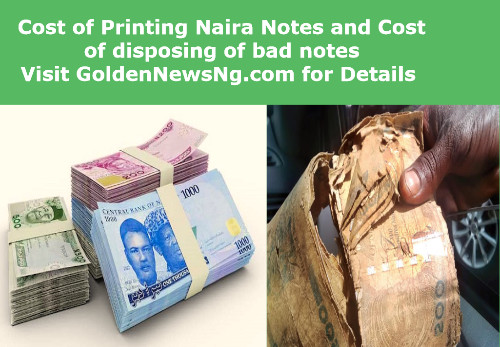CBN Gives Breakdown Cost of Printing Naira Notes and Cost of disposing of bad notes
The Central Bank of Nigeria (CBN) has provided a detailed breakdown of its financial performance and expenses for the 12-month period in 2022. Notably, an expenditure of over N29 billion was allocated to the printing and disposal of Nigerian currency notes. This sum covers the meticulous process of creating, processing, distributing, and retiring currency notes throughout the year.
The CBN, in accordance with Section 18(d) of the CBN Act 2007, is authorized to undertake the secure destruction of unfit banknotes on a regular basis. This process ensures the integrity of the currency in circulation and adheres to stringent security protocols.
The financial statement released by the CBN on its official website unveiled that a total of N29.64 billion was expended on activities related to currency notes in 2022. This figure represents a significant increase compared to the N15.23 billion allocated to the same operations in the previous year.
The Nigeria Security Printing and Minting (NSPM) Plc, along with occasional collaborations with international firms, is responsible for the printing and minting of Naira notes and coins. The CBN maintains legal responsibility for quality assurance and the receipt of finished currency materials.
The CBN’s annual report further divulged a breakdown of expenses related to printing new Naira notes over the years:
- 2016: N33.37 billion
- 2017: N49.52 billion
- 2018: N64.04 billion
- 2019: N75.52 billion
- 2020: N58.62 billion
Additionally, costs incurred for disposing of unsuitable notes were also provided:
- 2016: N1.43 billion
- 2017: N594.62 million
- 2018: N662.21 million
- 2019: N647.82 million
- 2020: N538.59 million
It’s worth noting that figures for the year 2021 have not been made available, and the statistics for 2022 are pending release.
Moreover, an intriguing report introduces Folashodun Adebisi Shonubi as the new acting Governor of the CBN. Shonubi’s professional journey is detailed, including his selection for the role by President Tinubu among four deputy governors: Aisha Ahmed, Edward Adamu, and Kingsley Obiora. According to legal stipulations, one of the deputy governors is required to complete the tenure initiated by Emefiele, which was originally set to conclude in May 2024.
To SEE MORE DETAILS OF CBN REPORT CLICK HERE
FAQ – Central Bank of Nigeria’s Currency Operations
1. What financial information has the Central Bank of Nigeria (CBN) disclosed for the year 2022? The CBN has provided a breakdown of its financial performance and expenses incurred during the 12-month period of 2022.
2. How much did the CBN spend on printing and disposing of Nigerian currency notes in 2022? The CBN allocated over N29 billion for the printing and disposal of Nigerian currency notes in 2022.
3. What is the purpose of the regular destruction of unfit banknotes by the CBN? The CBN, in accordance with Section 18(d) of the CBN Act 2007, securely destroys unfit banknotes to maintain the integrity of the currency in circulation.
4. Who is responsible for the printing and minting of Naira notes and coins? The Nigeria Security Printing and Minting (NSPM) Plc, along with occasional collaborations with international firms, handles the printing and minting of Naira notes and coins.
5. What is the CBN’s role in relation to the quality of currency materials? The CBN is legally mandated to ensure quality control and the receipt of finished Naira banknotes and coins.
6. What are the historical expenditures for printing new Naira notes and disposing of unfit ones? The CBN provided a breakdown of expenses for printing new Naira notes and disposing of unfit ones over various years, including 2016, 2017, 2018, 2019, and 2020.
7. Who is Folashodun Adebisi Shonubi, and what is his role at the CBN? Folashodun Adebisi Shonubi is the new acting Governor of the CBN. He was chosen among four deputy governors and is expected to complete the tenure initiated by his predecessor.
















